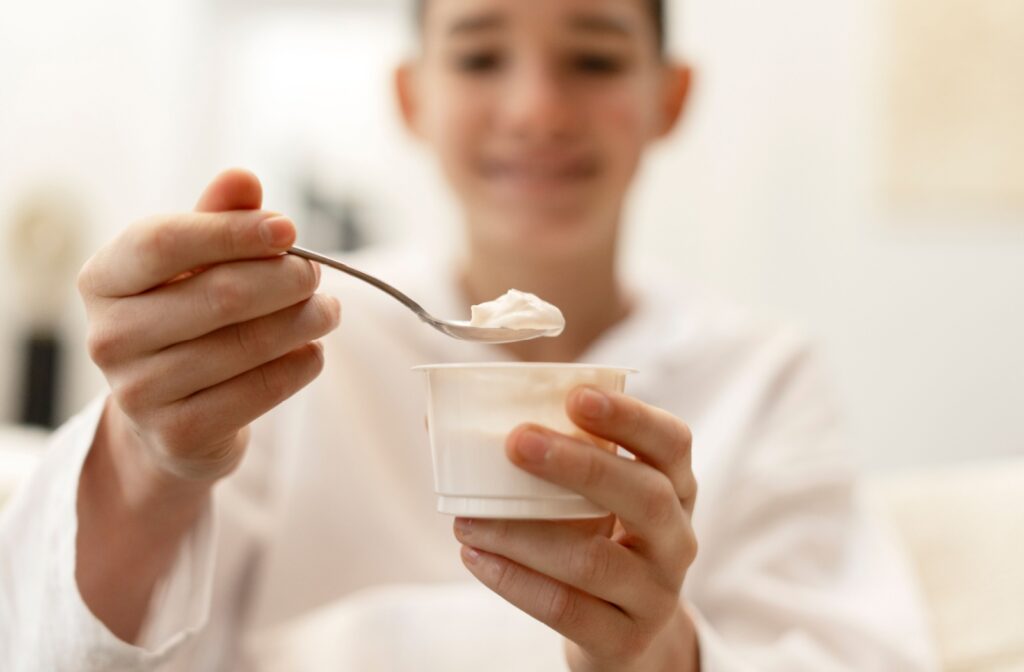Wisdom Teeth Food Timeline: What to Eat Day by Day After Surgery

Getting your wisdom teeth removed is a common dental procedure for many families. While the procedure itself is a straightforward tooth extraction, knowing what to eat afterward can feel a bit confusing.
A proper diet is a key part of a smooth recovery, helping you heal comfortably and get back to feeling like yourself. Following a day-by-day food timeline can help make your recovery as comfortable as possible.
We’re here to help break down what you can eat, from the first 24 hours to the second week and beyond. We’ll walk you through the process so you and your family can feel prepared for a successful recovery.
The First 24 Hours: Soft Foods & Gentle Care
The first day after your wisdom teeth removal is all about rest and recovery. Your mouth will be sensitive, so your diet should be gentle on the surgical sites.
Focusing on liquids and very soft foods that require no chewing can help the healing process and prevent irritation. Always follow your dentist’s post-operative care guidelines.
What to Eat Right After Surgery
For the first day, stick to simple and soothing options that you can consume without chewing. These foods are easy on your mouth and can provide the nutrients your body needs to heal. Lukewarm temperatures are ideal to avoid sensitivity.
- Lukewarm broths & smooth soups
- Yogurt
- Applesauce
- Pudding & jelly
- Ice cream
- Nutrient-rich smoothies
Foods & Drinks to Avoid
To protect the healing area, it’s a good idea to steer clear of certain foods and habits. These items can increase swelling, dislodge the protective blood clot, or irritate the sensitive tissue.
Avoid the following:
- Hot foods & beverages that can increase swelling
- Crunchy or hard foods
- Spicy or acidic foods
- Alcohol & caffeinated drinks
Important note: Do not use a straw. The suction can dislodge the protective blood clot.
Tips for Comfort & Swelling
Keep your head elevated, even while resting, to help reduce swelling. You can also use a cold compress on your cheek for about 15 to 20 minutes at a time during the first 24 hours. It’s also helpful to drink plenty of water to stay hydrated and support your body’s natural healing process.
Days 2 & 3: Your Transition to Semi-Soft Foods
As you move into the second and third day, you can start to introduce more substantial, yet still very soft, foods. Your comfort is the best guide, so listen to your body and don’t push it. If you feel any discomfort, it’s perfectly fine to stick with liquids for a little longer.
Safe Foods to Add to Your Diet
You can begin to add some texture back into your meals with the following easy-to-eat foods. Meals like scrambled eggs are great because they are soft and packed with protein. Remember to chew away from the surgical sites as much as possible.
Safe foods to eat include:
- Scrambled eggs
- Mashed potatoes
- Cottage cheese
- Oatmeal or porridge
- Soft-cooked pasta
What to Continue to Avoid
Continue to skip any foods that are hard, crunchy, sticky, or require a lot of chewing. Small grains and seeds like those found in rice, quinoa, or on some breads can get stuck in the extraction sites. It’s best to avoid these options for now in order to prevent irritation or potential infection.
Days 4 to 7: How to Expand Your Menu
By this stage, your pain and swelling should noticeably improve, which makes eating much easier. You can slowly begin to add more variety to your diet and explore different flavours again. Remember to chew carefully and use the side of your mouth away from the surgical sites.
Introduce More Substantial Foods
As you feel more comfortable, you can try incorporating these slightly more textured foods into your diet. Cooking vegetables until they are very soft or choosing ripe fruits makes them easier to manage. This is a great time to reintroduce foods with more substance.
- Soft, cooked vegetables
- Ripe bananas
- Tender, shredded chicken or pulled pork or beef
- Soft bread without a crust
- Well-cooked fish
Can You Eat a Burger or Quesadilla Yet?
Around day seven, you might be able to handle a soft burger bun with tender meat cut into very small pieces. A soft tortilla quesadilla without crunchy fillings could also be an option, but the key is to avoid strenuous chewing that could strain your jaw.
Gentle Oral Hygiene Habits
After the first 24 hours have passed, you can start to gently rinse your mouth with a warm saltwater solution. This should be done after meals to help keep the area clean and promote healing.
As you recover, you can gradually return to your regular routine of brushing and flossing. When you’re done rinsing, just let the water fall out of your mouth into the sink rather than spitting forcefully.

The Second Week & Beyond: Return to Your Normal Diet
After the first week, you can typically start reintroducing your normal diet. Healing takes time, so the goal is a gradual return to your normal routine as your comfort level allows.
Don’t feel you need to rush the process, as your jaw may still feel a bit stiff or tired. Once you’ve fully healed, it’s a great opportunity to focus on your long-term smile by exploring our range of general and restorative dentistry procedures.
How to Know You’re Ready for Regular Food
Your body will give you signals that it’s ready to get back to a normal diet. You’ll know you’re ready to get back to your usual meals when you notice a few key signs of healing. Trust your own comfort level as the most important indicator.
- You experience little to no pain when chewing.
- Swelling has gone down completely.
- You can open your mouth comfortably.
Reintroduce Your Favourite Meals with Care
Start with softer versions of your favorite foods, like a sandwich on soft bread instead of a crusty baguette. You can slowly work your way back to crunchier or tougher textures like nuts, chips, or steak. Pay attention to how your mouth feels and take it slow to avoid any setbacks in your recovery.
Common Questions About Your Post-Surgery Diet
It’s normal to have a few questions as you navigate your recovery from wisdom tooth surgery. Every person’s healing journey is a bit different, and it’s smart to be informed.
How to Handle Food Stuck in the Extraction Site
If you feel food has become lodged in the extraction site, a gentle rinse with warm salt water can often help dislodge it. Swish the water around your mouth very gently, then let it fall out. Avoid poking at the area with your tongue, a finger, or any objects, as this could disrupt the healing clot.
When Can You Use a Straw Again?
It’s a good idea to wait MINIMUM 24 hours and up to a 3 days before you use a straw. The sucking motion creates pressure in your mouth that can dislodge the protective blood clot from the socket. This condition, known as dry socket, can be painful and delay your healing.
What Are the Signs of a Problem?
While recovery is usually straightforward, it’s important to know the potential signs of a dental emergency .
As your dentist in Ottawa, we’ll give you specific instructions about caring for your mouth, but you should contact your dental office if you notice any of the following, as you may require emergency dental services:
- Pain that gets worse after day 3
- Bleeding that doesn’t stop with gentle pressure
- Fever or a bad taste in your mouth
Your Partner in Post-Operative Care
Navigating your recovery is simpler when your family has clear guidance. A personalized plan helps everyone feel confident at every stage of the healing process. Following professional advice can support a comfortable and timely recovery so you can get back to your favourite foods.
At Dow’s Lake Dental, we’re committed to making your experience a positive one. We know that life is busy, which is why we offer accommodating hours and let you book appointments via text. Our team also provides service in English, French, and Arabic to help everyone in your family feel at ease.
Oral health is connected to overall health, and treating dental issues early can help you avoid pain, infection, and more costly procedures later on. Come visit us at Dow’s Lake Dental and learn more about how to keep your smile healthy. We’re here to answer any questions you have about your post-operative care.


